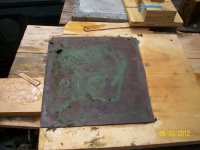After getting the Select II 1200 I decided to buy another stone from the same brand, the 6000 grit Select II stone. The first impression after an initial lapping is that is feels very smooth, kinda soft and velvet like. I really like how this stone feels. Think of it as a very, very refined version of the 1200. So how does it sharpen? Well, fast and smooth. It almost immediately starts to cut and produces a shaving sharp and very smooth edge. In fact, it's the kind of edge I get from my Coticules. The stone also resembles my Coticules in sharpening feel and feedback. I see absolutely no need for an even higher grit stone as a finisher. The Select II does a very good job at this. Time will tell how well it resists dishing but I suspect that with proper use of the full stone's surface it will stay flat a long time. I also like the speckled surface of the stone, it gives it some personality.



